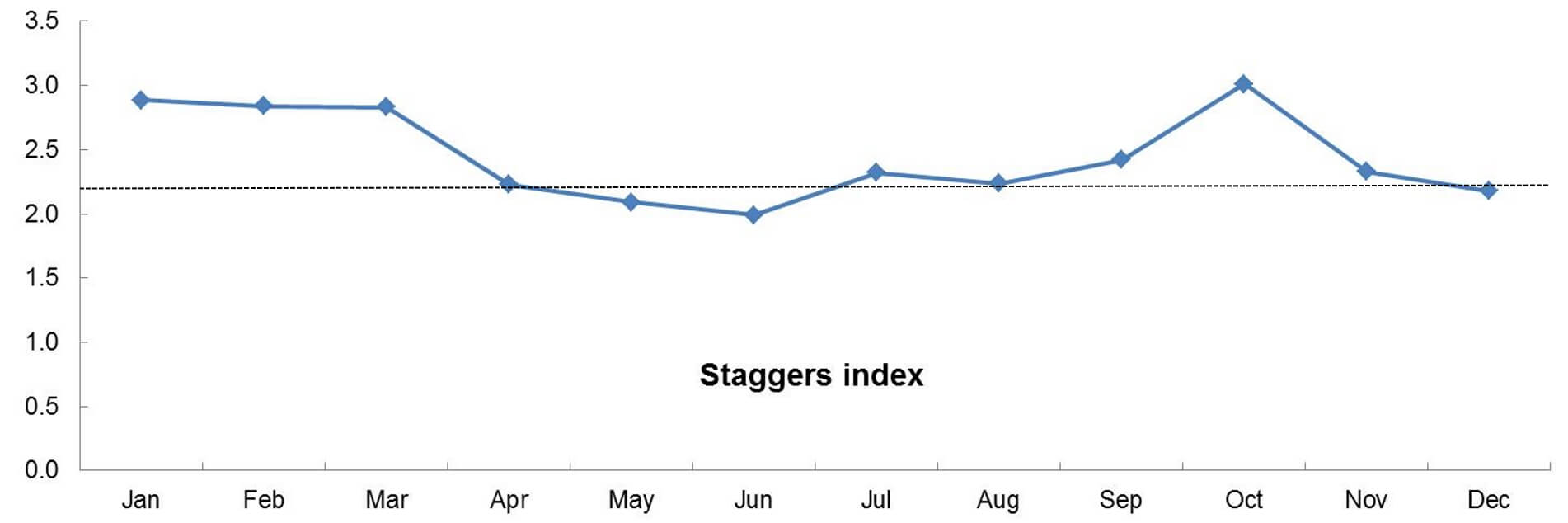Staggers index =
Ideally, the staggers index should be between 1.8 and 2.2. Unfortunately, from early spring, through peak summer and until mid-April it is mostly above 2.2, as demonstrated in the graph (Leaf data4).
In early spring, the negative staggers index effects are usually diluted by high levels of concentrates and supplements due to early lactation. Due to lower milk production in peak summer, late lactation cows usually receive less concentrates, and therefore have a higher dependency on pastures. These pastures have a high staggers index. The lower concentrates also means less minerals (eg.Ca) are fed.
Pastures on poorly balanced soils, which are dependent on high levels of nitrogen to get growth (Read more: Further proof of the positive effect of decreased nitrogen fertiliser), are far more susceptible to high potassium levels in the leaf (Read more: The potassium problem, or is it a nitrogen problem?), and elevated NPN5 levels, and therefore a high staggers index. The latter will make the cow far more prone to heat stress even though it might be subclinical staggers.
Staggers treatment is the same as for milk fever, but prevention is a better option. Since 2013 my clients in the high staggers zone have given an all day ad lib lick, giving the cow a free choice option. This way she tells us what her requirement is. No nutritional program can do this 100% correctly, especially when you are trying to maximise pasture intake, and minimise supplementation and concentrate levels. Environmental factors also vary from day to day. The result has been a dramatic decrease in flocculation and staggers cases, as well an easing of heat stress has occurred.
Flocculation/Staggers lick:
Intake should be between 35 – 75 g/cow/day. [Do not let this lick get wet!]
In the past when the milk buyer tested flocculated milk and found the phosphate levels to be too low, they then applied a straight line nutritional assumption and told the farmer to feed phosphates. The farmer then added dicalcium phosphate to the cow’s diet [di means two parts calcium and one part phosphates]. This, in many cases, due to the two parts calcium, helped decrease the milk flocculation. When mono calcium phosphate [one part calcium] became the cheaper source of phosphates, the effect was far less.
The truth is a shortage of calcium uptake (hypocalcemia) – due to oppressed magnesium uptake (hypomagnesemia) from excessive potassium, and/or due to an acidic rumen – will have a negative effect on the conversion of phosphates, which will reflect in the milk.
Conclusion
It is clear that calcium shortage, due to excessive potassium, is the foundation for lowering milk pH and therefore is the cause of milk flocculation in UHT processed milk. Still, the added effects of environmental and physical factors, as well as basic nutrition, will increase the incidents of milk flocculation. Below is a tick list to evaluate your specific situation, especially between 15 January and 15 April.
Footnotes:
- UHT stands for ”Ultra High Temperature” processed milk
- Grass Tetany is a complex disorder characterised by hypermagnesemia (low blood magnesemia). A high K intake can decrease the absorption of Mg from the gut inducing Hypermagnesemia. https://www.gov.mb.ca/agriculture/livestock/production/beef/print,potassium-and-tetany-ratios.html
- MUN stands for “Milk Urea Nitrogen”. Cows convert protein in the rumen into ammonia, which is used by the bacteria in the rumen. The excess ammonia (which is toxic), is converted to urea (which is not toxic) in the liver and kidney. Most of the urea is excreted in urine, but it is also readily absorbed into the blood, body tissue and milk. MUN values are closely correlated with the concentration found in the blood. Looking at the amount of urea nitrogen in a cow’s milk can provide an accurate reflection of how much nitrogen that cow is absorbing but not using for growth or to make milk. Most of this nitrogen comes from feed.
- Leaf Data: Hundreds of leaf samples taken in the Tsitsikamma on Ryegrass/Clover and Ryegrass/Clover/Kikuyu pastures over four years were analysed at Cumberland Valley Analytical Services Forage Lab (USA).
- NPN stands for “Non-Protein Nitrogen”. Too high levels of NPN can lead to excessive Blood Urea. These along with slightly elevated blood nitrate levels, Tetany and high temperatures, could make it hard for the cow to survive. In many cases, alkalosis of the rumen is present when the above occurs.
- Phosphates testing low in flocculated milk is not due to phosphate supply as leaf samples, along with concentrate levels, have shown way in excess of requirements. Phosphate shortages in the milk are therefore due to uptake inhibition and not due to an under supply of phosphates in the diet.
- Body builders and milk flocculation association - 2018-03-08




